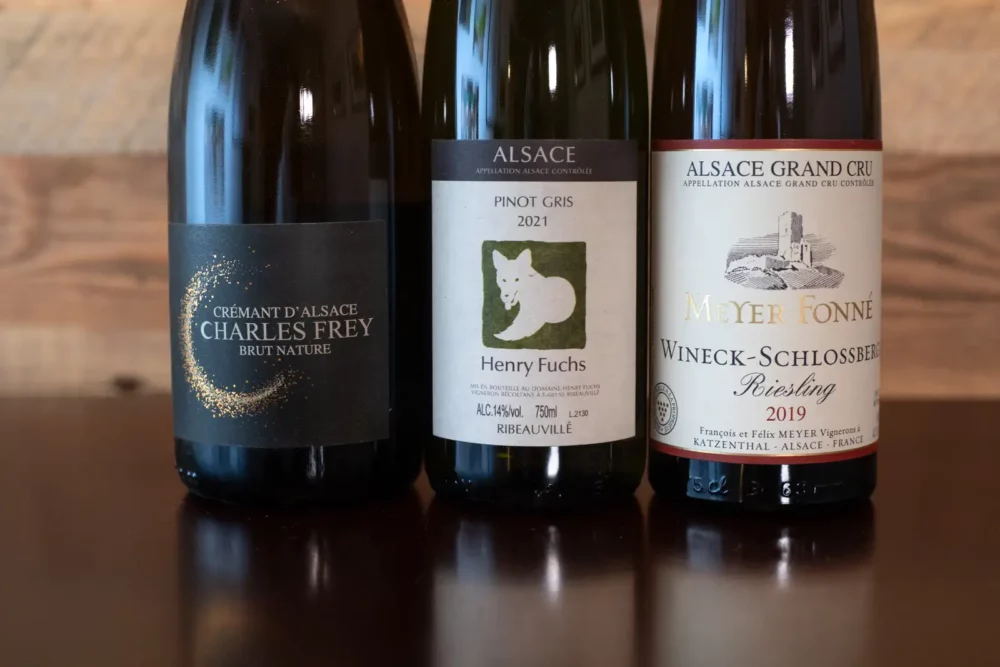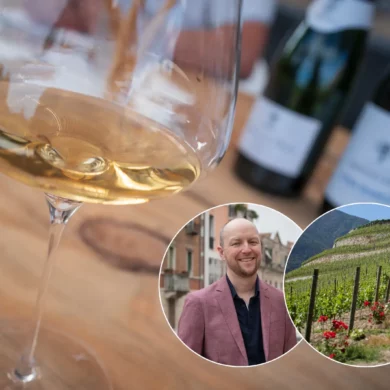Pop quiz: what’s complex and diverse, basks in the sun more than its peers, and has a chronically underrated reputation in America? Why its the wines of Alsace!
Yes, its time to return to one of my favorite wine regions. I recently returned to the Food, Wine & Whiskey Podcast with Rob Clark to discuss the basics (and not-so-basics) of the wines from Alsace. We tasted three different wines together, and I shared what I know about the region’s history, key grape varieties, trends, and why this region’s wines merit more attention from American wine lovers. If you want to take a deep dive (or even just skip around), I’ve embedded the podcast below as well as a rough time code to the discussion points below that.
A special thanks goes to Wines of Alsace USA for providing Rob and I with the same three wines. Because Alsace’s producers make so many different wines from year-to-year, and because distribution varies so much around the United States, finding the same exact wine from the same producer and same vintage can be tricky, especially since one of us is in Colorado and the other is in Texas. Learn more about our editorial policy.
I’ve also included notes on the wines below the time code below the podcast. Rob has also put much of the conversation on YouTube in different segments. Here is a preview:
Podcast Episode Guide
- Visiting Alsace and the lay of the land – 7:00
- Misconceptions about Alsace – 13:30
- Crémant d’Alsace – 19:45
- Why you should get to know Alsace – 20:50
- Emergence of Pinot Noir – 23:15
- Brief history of Alsace – 29:00
- The duality of its culture visible on the label – 35:15
- Soils of Alsace – 38:20
- Key Grapes of Alsace – 43:20
- Styles and vintage variation – 49:35
- Tasting
- Crémant d’Alsace from Charles Frey – 53:00
- Pinot Gris from Henry Fuchs – 58:00
- Grand Cru Riesling from Meyer-Fonné – 1:04:15
- Planning a visit to Alsace – 1:16:00

2019 Charles Frey Crémant d’Alsace Brut Nature
Crémant d’Alsace AOC (Alsace )
Grapes: Pinot Blanc, Auxerrois and Riesling
Alcohol: 12.5%
Opinion: ★★★★ 1/2
Food friendliness: Impeccable
Value: Exceptional
A beginner might like … savoring a high-quality traditional-method sparkling wine for a pittance. At a mere $25, this lees-forward wine has all the caress and textural seduction of a champagne priced twice as much.
A wine obsessive might like … the role Riesling plays in the cuvée of Crémant d’Alsace. Champagne’s symphony doesn’t rely on the timpani and bass as much as Crémant d’Alsace does. Even in a minor role such as here, Riesling provides depth and detail. Another factor: Alsace’s sunny and warm climate, which lends more richness to all grapes involved. Charles Frey’s version certainly shows these traits.
Like How We Write Wine Reviews?
Subscribe to Opening a Bottle and unlock hundreds of wine reviews as well as our live and recorded wine classes, all for just $79/year or $9/month.
2021 Henry Fuchs Alsace Pinot Gris
Alsace AOC (Alsace )
Grapes: Pinot Gris (100%)
Alcohol: 14%
Opinion: ★★★★ 1/4
Food friendliness: Versatile
Value: As Expected
A beginner might like … the classic Pinot Gris/Pinot Grigio profile of pears, white flowers and herbs. Memorize this aroma if you can, because it is what Pinot Gris should smell like.
A wine obsessive might like … picking apart the balance of acidity and flesh on the palate profile of this wine. Clearly these grapes saw some sun, yet retained their acidity to keep things moving. Is it enough? Personally, I would have liked to feel more sharpness from the latter on this wine, just to make it more quenching. However, the aromas and flavors felt varietally correct and pure.

2019 Meyer-Fonné Alsace Grand Cru Wineck-Schlossberg Riesling
Alsace Grand Cru AOC (Alsace )
Grapes: Riesling (100%)
Alcohol: 13.5%
Opinion: ★★★★ 1/2
Food friendliness: Selective
Value: A Little Pricey
A beginner might like … the aromatic complexity of this Riesling. Sourced from Grand Cru vines (see photo above), some of which were planted in 1958 and 2010, this wine certainly has the raw ingredients to showcase what makes Alsatian Riesling so famous. Note the leathery persistence on this finish.
A wine obsessive might like … sorting out the residual sugar situation. With an Indice 2 on the side label confirming what I was tasting, this wine is off-dry and that leads to a stylistic debate. Meyer-Fonné already has four Vendage Tardive wines and three more with noble rot (Selection Grain Nobles). Obviously, those are significantly sweeter and serve a different purpose, but off-dry sometimes feels like purgatory. Personally, I would have liked to see this wine showcase its complexity with fleeter feet and be vinified dry, but perhaps that would have thrown the alcohol too high.





